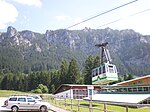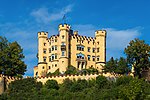Neuschwanstein (meteorite)

Neuschwanstein was an enstatite chondrite (type EL6) meteorite that fell to Earth on 6 April 2002 at 22:20:18 GMT near Neuschwanstein Castle, Bavaria, at the Germany–Austria border. The original meteorite burst into several fragments at a height of about 22 kilometers (14 miles) above the ground. The fragments descended on an area of several square kilometers. Three fragments were recovered with a total mass of about 6 kilograms (13 lb). Neuschwanstein was the first meteorite in Germany, and the fourth in the world, that was monitored by one of the world's fireball networks, namely by the European Fireball Network. Photographing the meteor simultaneously from several locations allowed accurate reconstruction of its trajectory.
Excerpt from the Wikipedia article Neuschwanstein (meteorite) (License: CC BY-SA 3.0, Authors, Images).Neuschwanstein (meteorite)
Neuschwansteinstraße,
Geographical coordinates (GPS) Address Nearby Places Show on map
Geographical coordinates (GPS)
| Latitude | Longitude |
|---|---|
| N 47.5575 ° | E 10.75 ° |
Address
Schloss Neuschwanstein
Neuschwansteinstraße
87645
Bavaria, Germany
Open on Google Maps










